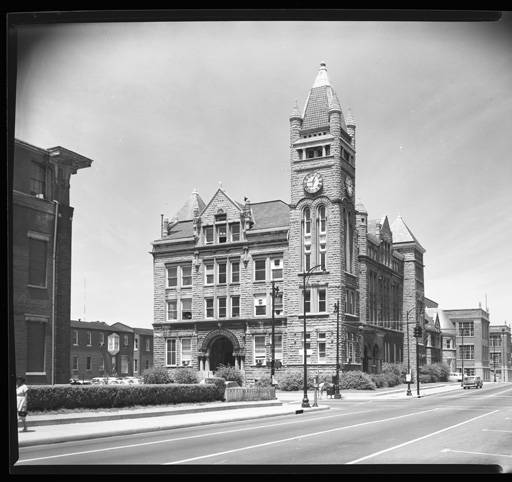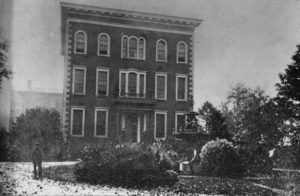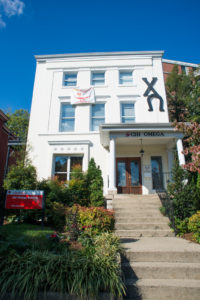
Despite the deep history of the University of Louisville and its adjacent location to the spiritual hotbed that is Old Louisville, there is not an abundance of ghost folklore involving campus.
Still, that doesn’t mean the university doesn’t have any mystery or intrigue. After all, the cremated remains of Supreme Court Justice Louis D. Brandeis and his wife, Alice Goldmark Brandeis, are buried underneath the portico at the law school. Students leave coins and animal crackers on their graves before exam week, attempting to conjure up some luck from the dead.
We asked Tom Owen, archivist for regional history in Archives and Special Collections, if he knew of any more detailed campus ghost stories.

“The only thing we can come up with is the fact that before our campus was developed as a city-owned orphanage/reform school in 1860, it was a city cemetery for almost 10 years called, variously, Southern or Oakland,” Owen said. “We have evidence that there were burials, but our sources indicate that the bodies were disinterred and reburied at Cave Hill.”
There is, however, the story of UofL’s Chi Omega sorority house, which is outlined in the book, “Haunted Homeland: A Definitive Collection of North American Ghost Stories,” by Michael Norman (2006). He writes:
“The sisters at the Chi Omega sorority house got along famously with a ghost named George. They knew it was a male because passersby looking through the large front window at night sometimes noticed a bulky figure wearing a suit and standing on the staircase. Just who it was no one seemed to know. In absence of an identity back in 1984, someone took to simply calling him George.
“The Chi Omega women didn’t live in the house, so there weren’t many instances of nighttime shenanigans by George. They did figure out that he seemed to live on a back staircase that connected with the kitchen because footfalls as if someone was trooping up those steps were heard during the daytime …”

One of the sorority sisters told a reporter that when she was alone in the house, lights would blink on and off, which seemed to be George’s favorite activity.
“The plink-a-plink of single notes struck on the living room piano also alerted sorority members that George was about.”
Uncomfortable moments aside, the sorority sisters described George as a friendly ghost.
In 2012, The Louisville Cardinal also examined ghost stories throughout the city, noting some haunted downtown landmarks such as the Palace Theater and the Brown Hotel. The only UofL connection mentioned in the story was the old Medical Department, 101 W. Chestnut St.
The building was formerly a part of Louisville Medical College and was acquired by UofL in 1909. It is now owned by the Greater Louisville Medical Society Foundation and it is said to harbor mysterious footsteps, squeaky gurney wheels and other heart-racing noises that are likely unsettled spirits from the old Medical School, which opened in 1893.
From the Cardinal:
“The school has a tradition of innovation in medicine. For example, in 1911, the facility launched the nation’s first trauma care center, in 1970, the Pap Smear was invented, and in 1999, the first successful hand transplant was performed. But the school has a tradition of spooky happenings as well … The medical school is home to the Wolf Gallery, a location where the art of physicians and their families is displayed. On the tile floor at the end of the gallery is a permanent stain. This stain developed when the rooms of the Wolf Gallery were still anatomy classrooms. Students would often leave the rooms carrying trays of heads or limbs which were soaking in blood or formaldehyde. Sometimes the students would let their guards down, and the solution would slosh onto the floor. After years of this treatment, the stain formed, and cannot be removed …
“In the basement of the building is the old embalming room, which was not a popular hangout for medical students. In it was a vat in which cadavers would soak in formaldehyde in the fetal position. When a body was required, it would be removed from the vat and hung on a hook to drain into a trough. This trough led directly into the city sewer. In 1996, the basement was renovated. While redoing the ceiling of one room, workers were surprised when a body part fell out of the ceiling. The school’s coroner ruled that the part had simply been misplaced.
“In the late 1930s, one student at the school failed an exam which caused him to be expelled from medical school. Distraught, the student hung himself in the school’s four-story stairwell. Some time later, his professor noticed that he had made a grading error on the mathematics portion of the test, and that the student had actually passed. The professor was so upset that he committed suicide in the same way that his student had …”
For obvious reasons, the building has been a stop on many ghost walking tours in the city.

































